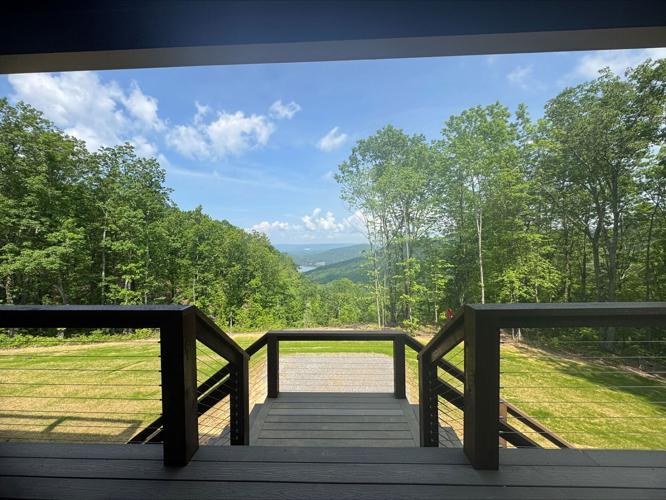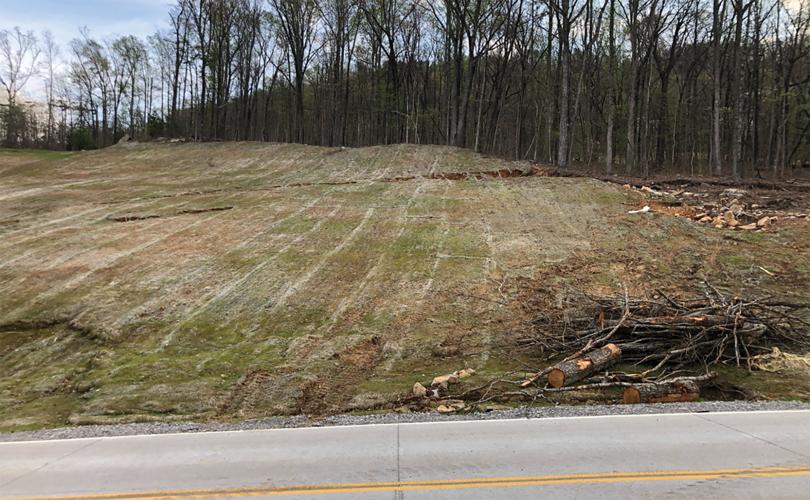
The view from the porch of a family who became the first to move into a River Gorge Ranch home
Last week, Sicily’s Mt. Etna erupted with “thunderous booms,” as it’s done all spring. The same could be said of Tennessee’s Aetna Mountain, which undergirds John “Thunder” Thornton’s River Gorge Ranch development near Chattanooga. The local noise is produced not by lava, but by blasting in a new quarry on the mountain’s flank, extracting limestone for roadbeds; by machinery paving those roads; and by the whine of construction equipment building the first few dozen of as many as 2,500 projected homes in the mountaintop development. And none of that’s to mention a 13,000-square-foot restaurant, scheduled to open this summer.
Thornton’s company Thunder Air filed a lawsuit against two local residents who claimed the mountain was a “Swiss cheese” of mines. The company lost the suit last year, with a judge awarding the residents more than $200,000 in attorneys’ fees. While the entire development sits above 150 years’ worth of mining, the developer insists the surface is safe for building because of thick layers of sandstone between homesites and old mines. (Some lots cover former strip mines, active on the surface as recently as the 1980s. The developer removed from sale a few lots found to contain strip-mining spoils.)
An East Tennessee development is moving forward on what locals call a ‘Swiss cheese’ of abandoned coal mines
But as the Scene reported a year ago, other problems persist for owners of the 615 lots sold to date.
Then as now, buyers await public water. In April of this year, a social media post to lot owners proclaimed, in an update purported by the sender to be “directly from the developer”: “We will have a water supply source. They are constructing a 16-inch water main up the mountain to provide city water.” One longtime area resident who requested anonymity calls the path “an ugly trench up the mountainside.” The route crosses rugged land that was once part of a state wildlife preserve, purchased at auction by Thornton when he assembled the first pieces of RGR.
“We’ve already invested over $5 million and laid over six miles’ worth of water lines,” says Dane Bradshaw, president of Thunder Enterprises. The only problem with connecting to a water source is that the new pipeline ends at the border of Black Creek, an earlier development on the Chattanooga side of the mountain. Until this real estate competitor gives Thunder an easement across Black Creek land, the taps remain closed.
Bradshaw explains that Tennessee American Water, the company that will serve RGR, is negotiating with Black Creek for the easement. “A lot of that is a timing thing in terms of the engineering where the water lines go, because of where Black Creek’s future phase has to go,” he says.
A Tennessee American spokesperson confirms the company is “in discussion” for the rights. If the discussion is fruitful, the next round of pipe construction can begin, with Bradshaw predicting that homes and the restaurant might have water as soon as “late summer.” A planned 1 million-gallon water tank will be delayed a few years, Bradshaw says, because the first group of homes can be served by direct lines.
In March, the developer made an offer to the construction companies building nearly finished homes: a “well reimbursement option,” with the developer paying for private wells to be drilled. One of these wells came in a few weeks ago, its water brought up from deeper than some old mines. “Abandoned mines with associated acid mine drainage (AMD) discharges are among the greatest threats to ground and surface water quality in many areas of the United States,” according to the nonprofit Ground Water Protection Council.
The lot’s owner did not respond to a request for comment on water quality.

Slumps along the road
New roads wind through the development, but road approval remains in limbo from a county government disagreement over how the county can legally inspect or approve private roads. The single road now open to the public, a switchback up the mountain to the main entrance, developed several small slumps along its borders after recent rains, as photographed by Max Dahlquist, a geology professor at Sewanee. Bradshaw says these are rock buttresses, created to allow runoff from saturated soils through drains, adding, “There have been zero issues with the road itself.”
East Tennessee developer behind River Gorge Ranch must pay for costly 'Swiss cheese' suit
“It’s a mess,” says one person familiar with RGR construction, who spoke anonymously for fear of job retribution. This source says the required bonds put up by the developer fall far below the estimated cost for road and infrastructure construction for the site. “None of those roads have been tested. None of the asphalt was tested. The bond’s not good enough. Last I heard it was $4.1 million total for three bonds that won’t even cover the water line they’re putting in, let alone power.”
Bradshaw insists that the roads in Jasper Highlands, Thornton’s previous mountain development, were the first in Marion County to be built with four inches of asphalt, and that the RGR roads will be built beyond county specs.
“We don’t cut corners, we don’t cheat, we don’t steal, we don’t lie, and we don’t have well-placed friends,” he says. “What we do is we put our head down, and we work our butt off every single day. We do the right thing.”
Coming in our May 22 issue: a look at RGR and the good ol’ boys running Marion County.








